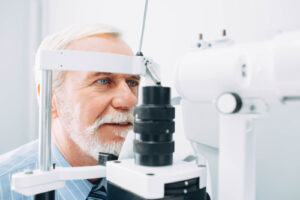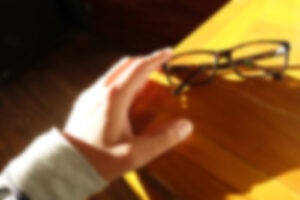Most of the time, cataracts develop very slowly. Unless your cataracts are advanced upon diagnosis, your eye doctor might not recommend cataract surgery right away.
Once you are diagnosed with cataracts, your eye doctor will monitor them closely until you feel you require better vision.
Keep reading to learn more about cataracts, why you may not need cataract surgery right away, and when to have your cataracts removed!
What is a Cataract?
A cataract is the clouding of your eye’s natural lens. Cataracts occur when proteins in your lens break down and form clumps.

These clumps prevent light from passing through clearly, causing your vision to become cloudy or hazy. Cataracts are typically due to the natural aging process inside the eye.
Other factors can also increase your risk of developing cataracts, such as:
- Eye trauma
- Diabetes
- Smoking
- Previous eye surgery
- Long-term use of certain medications like corticosteroids
- Excessive exposure to the sun’s UV rays
What Are Some of the Most Common Symptoms of Cataracts?
Cataracts cause several symptoms that often worsen with time. Although not everyone will experience all of these symptoms, some of the most common ones are:
- Blurred vision
- Halos and glare
- Poor night vision
- Increased sensitivity to light
- Double vision in one eye
- Frequent prescription changes
- Colors appearing faded
- Need for brighter lighting
Why Cataract Surgery Might Not Be Necessary Immediately

Cataracts often form gradually over many years, and the symptoms typically appear slowly. Thus, mild cataracts likely won’t significantly affect your vision or prevent you from leading a productive and active life.
A stronger prescription can help you see clearly in the early stages of cataracts. Additionally, your eye doctor may suggest using brighter lighting at home.
Because cataracts block light from entering your eye, improving the lighting in your house will make it easier for you to read, cook, and do other up-close tasks. Also, wearing polarized sunglasses and a wide-brimmed hat whenever you go outside can reduce glare.
Other tips your eye doctor may recommend to manage your symptoms when you have mild cataracts are:
- Using a magnifying glass to read.
- Increasing the text size on your smartphone, tablet, laptop, and computer to see clearly.
- Limiting your night-time driving since visibility is usually reduced, and it can be more challenging to deal with halos and glares.
- Contrasting colors to help differentiate things and show you borders of steps, sofas, counters, and more.
Signs It’s Time to Have Cataract Surgery
Ultimately, your eye doctor will determine the appropriate time for you to have cataract surgery, depending on your symptoms and how they interfere with your day-to-day life. Delaying treatment against your doctor’s advice can lead to even worse vision and a lower quality of life.

That’s because a stronger prescription, brighter lighting, and a magnifying glass are only temporary fixes that can only go so far. The best long-term solution is to have cataract surgery.
The thought of surgery may seem extreme. However, cataract surgery is an incredibly safe procedure and the only way to regain clear vision.
Here are some signs that it could be time to have your cataracts removed:
Trouble with Nighttime Driving
With time, driving at night can become very challenging. You may find it difficult to read the street signs due to halos and glare.
Due to glare, oncoming headlights from vehicles can make driving even more challenging, especially at night. If you’re struggling with poor night vision, it’s essential to stay off the road until you have your cataracts removed.
This will ensure your safety and that of everyone on the road.
Double Vision in One Eye
Double vision is disorienting and dangerous. It can prevent you from completing routine day-to-day tasks and even cause falls.
So if you’re seeing two or more images of the same object, it could be time to have cataract surgery.
Everything Has a Yellowish, Brownish Tint
Down the line, everything around you will seem to have a brownish or yellowish tint due to cataracts. Colors will look muddy instead of bright and vibrant.
Seeing the world like this only gets worse as time goes by. The only solution at this point is to have your cataracts removed.
Your Prescription Keeps Changing
At a certain point, it’s unusual for your glasses or contact lenses prescription to change with age. But if it doesn’t stop fluctuating and a stronger prescription is no longer effective, you should have cataract surgery in order to improve your vision.
You’ve Injured Yourself Because of Poor Vision
Cataracts continue to cause your lens to become more opaque, making it harder and harder to see. If you’ve suffered a fall or an injury due to poor vision from cataracts, it’s time to consider surgery.
Removing your cataracts and replacing them with an artificial IOL can fully restore vision and help prevent avoidable slips, trips, and falls.
Sudden Vision Improvement

Also known as second sight, an abrupt vision improvement can happen with cataracts. Even though you may suddenly see clearly, it’ll only be short-lived and may even be followed by even worse vision than before.
If you notice you can see better than ever and have cataracts, that’s an indication that cataract surgery is on the near horizon.
Protect Your Vision from Cataracts
Cataract surgery at Joshi Retina Institute is an incredibly successful procedure. If cataracts are getting in the way of your day-to-day activities, the highly experienced cataract surgeons at Joshi Retina can help you recover your sight.
Do you want to know if it’s the right time for cataract surgery? Schedule a cataract consultation at Joshi Eye Insitute in Boynton Beach, FL, today.



